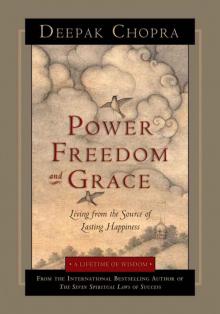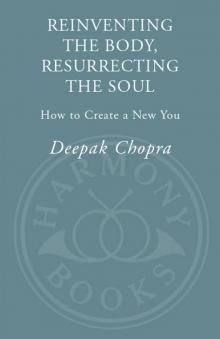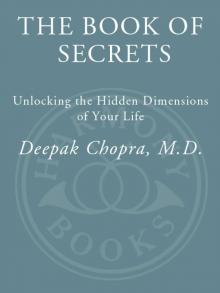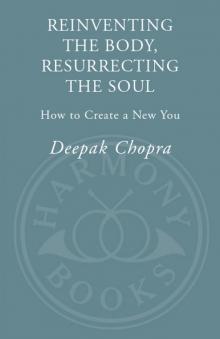- Home
- Deepak Chopra
The Book of Secrets: Unlocking the Hidden Dimensions of Your Life Page 14
The Book of Secrets: Unlocking the Hidden Dimensions of Your Life Read online
Page 14
People assume that the dark side of human nature has unstoppable power; Satan has been elevated into the equivalent of a negative God. But when it’s broken down, evil turns out to be a distorted response to everyday situations. Imagine yourself sitting alone at night in an empty house. Somewhere else in the house, there’s a noise. Instantly you recognize the sound of a door creaking open. Every sense goes on full alert; your body freezes. With difficulty, you resist the urge to call out, and yet a tremendous anxiety has leapt out of hiding. A robber! A murderer! Everyone has suffered through these agonizing seconds before the creaking door turns out to be a loose floorboard or the entry of someone coming home unexpectedly. But what really happened in that moment of dread?
Your mind took an insignificant bit of data from your environment and caused it to take on meaning. In itself, the sound of a creaking door is trivial, but if you unconsciously harbor fears of being attacked in the dark—and no one can help harboring such fears—the leap from a bit of sensory data to full-blown anxiety seems automatic. But in the gap between the noise and your reaction, an interpretation crept in, and it was the intensity of the interpretation (“Someone’s breaking in! I’m going to be killed!”) that created the danger.
What I’m suggesting is that evil is born in the gap between body and mind. There is no powerful ruler of the kingdom of evil. Satan started out as a moment of sensory input that got wildly out of hand. Take the fear of flying, one of the most common phobias. People who suffer from it usually have a vivid memory of when it began. They were on a flight and suddenly, just as with the creaking door, some noise of the plane or a sudden jolt made their awareness grow supersensitive. Insignificant sensations like cabin vibration and the rise and fall in the pitch of engine noise suddenly felt ominous.
Between these sensations and the reaction of fear there was a gap that lasted a fraction of a second. Tiny as it was, this gap allowed an interpretation (“We’re going to crash! I’m going to die!”) to attach itself to what the body was feeling. An instant later, the typical signs of anxiety—sweaty hands, dry mouth, racing pulse, dizziness, and nausea—added to the persuasiveness of the threat.
Phobics remember their first moment of uncontrollable panic without being able to take it apart in steps. Therefore, they don’t see their reaction as self-induced. That fear was a by-product of the following ingredients:
Situation: A normal situation is infused with something unusual or slightly stressful.
Bodily response: We experience a physical reaction that is associated with the stress.
Interpretation: These physical signals are labeled as signs of danger, and unconsciously the mind jumps to the conclusion that the danger has to be real (the unconscious mind is very concrete, which is why nightmares seem as threatening as actual events).
Decision: The person chooses to think “I am afraid right now.”
Because these ingredients fuse so quickly, they seem to be a single response, when in fact there is a chain of tiny events. Every link of the chain involves a choice. The reason we can’t let raw sensation go without interpreting it is that for reasons of survival the human mind was built to find meaning everywhere. Phobias can be treated by slowly taking the phobic person back through the formative chain of events, allowing him or her to make new interpretations. By slowing the response down and giving the person time to look at it, the knot of fear can be undone. Gradually, the noises associated with flying return to their neutral, nonthreatening place.
The fleeting gap between sensation and interpretation is the birthplace of the shadow. When you go into the gap and see how intangible everything is, the ghosts begin to disperse.
Because terrorism now weighs so heavily on people’s minds, the issue of mass evil cannot be avoided. The two most troubling questions are “How did ordinary people agree to participate in such evil?” and “How could innocent people become the victims of atrocities?”
The Stanford Prison Experiment and our discussion of the shadow come close to answering these questions, but I can’t give one answer to satisfy all comers—any time evil is brought up, we find ourselves visited by our own shadow. What could I have done about Auschwitz? a voice inside us says, usually in guilty, accusing tones. No answer will ever reverse the past, but it’s important to realize that no answer should be expected to.
The best approach to mass evil is not to keep remembering it but to renounce it so completely in yourself that the past is purified through you. My best answer to “How did ordinary people agree to participate in such evil?” lies in the pages you’ve just read. Evil is born in the gap. The gap isn’t anyone’s private possession. The gap contains collective responses and collective themes. When an entire society accepts the theme of “the outsiders” who cause all the trouble, then evil has everyone for a father and mother.
Yet in every case of mass evil, there were thousands of people who didn’t identify with the collective impulse—they resisted, escaped, hid, and tried to save others. It’s individual choice that determines whether you latch on to the collective theme and agree to play it out.
The second question, “How could innocent people become the victims of atrocities?” is more difficult, because almost everyone’s mind is already closed. The questioner doesn’t want a new answer. There is too much righteous anger, too much certainty that God turned his back, that no one wanted to risk their own lives to stop the enormous evil being done to others. Are you certain of these things? Being certain is the opposite of being open. When I ask myself why six million Jews perished or why equally innocent masses perished in Rwanda, Cambodia, or Stalinist Russia, my motive is first to release my own sense of anguish.
As long as I am overcome by anguish or righteous anger or horror, my ability to choose has been shut down. What I should be free to choose is purification, a return to innocence made possible by the shock of what happens when innocence isn’t nurtured. You and I are responsible for our participation in the elements of evil even though we don’t act out those elements on a mass scale. Believing in them keeps our participation going. So it’s our duty to stop believing in “harmless” anger, jealousy, and judgment of others.
Is there some mystical reason why an innocent person becomes the target of evil? Of course not. People who talk about the karma of victims as if some hidden fate is bringing down a rain of destruction are speaking from ignorance. When an entire society engages in mass evil, outer chaos reflects inner turmoil. The shadow has erupted on a mass scale. When this happens, innocent victims are caught in the storm, not because they have some hidden karma but because the storm is so overwhelming that it engulfs everyone.
I don’t view the relation of good and evil as a struggle of absolutes; the mechanism that I’ve been describing, in which shadow energies build up hidden power by depriving a person of free choice, is too convincing to me. I can see in myself that dark energies are at work, and being aware is the first step to illuminating the darkness. Awareness can remake any impulse. Therefore, I don’t accept that evil people exist, only people who have not faced their shadows. There is always time to do that, and our souls are constantly opening new ways to bring in the light. As long as that’s true, evil will never be fundamental to human nature.
CHANGING YOUR REALITY TO ACCOMMODATE THE EIGHTH SECRET
The eighth secret is about the mind’s “dark energy,” to borrow a phrase from physics. The shadow exists out of sight. To find it, you have to be dedicated to a journey of descent. Think of this journey as going back to retrieve parts of your life that have been abandoned because you felt so ashamed or guilty about them. The anger that erupts from the shadow is attached to past events that were never resolved. Now those events are over and gone, but their emotional residue isn’t.
Shame, guilt, and fear cannot be accessed by thinking. The shadow isn’t a region of thoughts and words. Even when you have a flash of memory and recall such emotions, you are using a part of the higher brain—the cortex—that cannot touch the
shadow. The journey of descent begins only when you find the doorway to the lower brain, where experience is sorted out not according to reason but according to intense feelings.
There is an ongoing drama inside your lower brain (identified with the limbic system, which processes emotions, and the reptilian brain, which reacts in terms of raw threat and survival). In this drama, many issues that would be interpreted reasonably by the higher brain—getting stuck in traffic, losing out on a business deal, being passed over at work, having a girl turn you down for a date—trigger irrational responses. Without realizing it, everyday events are causing your lower brain to draw the following conclusions:
I am in danger. I might be killed.
I must go on the attack.
I am so hurt, I will never recover.
These people deserve to die.
They put me in agony.
I don’t deserve to exist.
Everything is hopeless—I’m lost in the dark forever.
I’m cursed.
Nobody loves me.
To communicate these feelings on the page, I’ve had to verbalize them, but in reality, the most appropriate way to view them is as energy—strong, impulsive forces that have an impetus all their own. Rest assured, no matter how free you feel from these shadow energies, they exist inside you. If they didn’t, you would be in a state of total freedom, joy, and unboundedness. You would be in unity, the state of innocence regained when the hidden energy of the shadow has been purified.
Today you can begin to learn how to feel your way into the shadow. Shadow energies make themselves known whenever
You can’t talk about your feelings.
You feel out of control.
You feel a flash of panic or dread.
You want to feel strongly, but your mind goes blank.
You find yourself breaking down in tears for no reason.
You have an irrational dislike for someone.
A reasonable argument turns into warfare.
You attack someone without provocation.
There are countless other ways that the shadow gets entangled in everyday situations, but these are among the most common. What they have in common is that a boundary is crossed—a controlled situation turns unexpectedly anxious or causes unexpected anger or dread. The next time you experience this, watch and see if you feel guilty or ashamed of yourself afterward; if so, then you have touched, however briefly, on the shadow.
An eruption of irrational feelings isn’t the same as releasing them. Venting is not purification. So don’t mistake an outburst for catharsis. Shadow energy is purified through the following steps:
• The negative feeling comes up (anger, grief, anxiety, hostility, resentment, self-pity, hopelessness).
• You ask to release it.
• You experience the feeling and follow where it wants to go.
• The feeling leaves through breath, sound, or bodily sensations.
• You have a sense of release afterward, coupled with an understanding of what the feeling meant.
It’s the last step that tells the tale: When a shadow energy truly leaves, there is no resistance anymore, and you see something you didn’t see before. Insight and release go together. The journey of descent consists of encountering your shadow many, many times. Emotions as intense as shame and guilt give themselves up only a bit at a time—and you wouldn’t want more. Be patient with yourself, and no matter how little you think you’ve released, say to yourself, “That’s all the energy that was willing to be let go right now.”
You don’t have to wait for full-blown eruptions from the shadow. Set aside a little time for a “shadow meditation,” in which you give yourself permission to feel whatever wants to come up. Then you can begin the process of asking it to release.
Exercise #2: Writing as a Trigger
Another useful trigger for getting at shadow energies is automatic writing: Take a piece of paper, and start writing the sentence “I am really feeling right now.” Fill in the blank with any feeling that comes up—preferably a negative feeling that you had to keep to yourself that day—and keep writing. Don’t stop—write as fast as you can, putting down any words that want to stream out of you.
Other sentences that you can use to begin this exercise might be:
“What I should have said was .”
“I can’t wait to tell someone that I .”
“Nobody can stop me from saying the truth about .”
“Nobody wants to hear me say this, but .”
Through these triggers, you are giving yourself permission to express yourself, but the more important aim is to get at a forbidden feeling. That’s why the words don’t matter. Once you access the feeling, the real work of release can begin. You need to go on and feel it completely, ask for release, and keep going until you get a new bit of self-understanding. It may take practice before any real deep release comes to you, but step by step the walls of resistance will come down. The shadow is subtly involved in everyday life. It is never so hidden that you cannot bring it to light.
Secret #9
YOU LIVE IN MULTIDIMENSIONS
LAST WEEK I MET TWO PEOPLE who could start a spiritual feud if they weren’t so gentle. The first was a woman with a conscience. Having realized a fortune in the clothing business, she knew that much of the finery we put on our backs is made under sickening conditions in the Third World, where children work sixteen-hour days for pennies. Having seen these conditions firsthand, the woman became a dedicated activist.
“We have to wipe out slave labor,” she told me with passion in her voice. “I can’t understand why everyone isn’t outraged by what’s going on.” I could tell that she really wanted to know why I wasn’t outraged. Her eyes, with the intense, feverish gaze, were fixed on me. “You of all people,” they said. Not that I needed reminding. When you live a life publicly associated with spirituality, people want to know why their brand of spirituality isn’t the one you embrace. In this case, the woman with a conscience thought that the highest form of spirituality was humanitarianism; to her way of thinking you aren’t really spiritual unless you help the poor and fight injustice and inequality.
A few days later, I met her opposite in a man who earns his living performing healing at a distance. He was born in South America and found out, through mysterious experiences as a child, that he could see into the subtle world of auras and energy fields. For a long time nothing came of this gift; he was in the import-export business until he was over forty. Then one day he fell ill and found himself going to a healer who cured him without laying on hands—simply by moving his energy psychically. From that moment on, the man became passionate about doing the same kind of work. And he, too, wanted to know why I wasn’t following his version of spirituality.
“Changes are about to happen on the astral plane,” he said in a low, reserved tone. “Science has been in power on the material plane, but there’s going to be a turnaround in 2012—I’ve been told this by my spirit guides. From that year on, science will decline, destroyed by its own excesses. Then spirit will return to the planet.”
Instead of a passionate humanitarianism, this man advocated detachment and withdrawing from the material world. Like the first woman, he couldn’t understand why I didn’t catch on—it was obvious to him that trying to change the world by confronting it was hopeless.
Strangely enough, I agreed with both of them. What they represented was a secret: Each of us lives in multidimensions. We can choose where to focus our attention, and wherever that focus goes, a new reality opens up. Even though they disagreed with each other, both of these people were trying to solve the same problem, which is how to be spiritual despite the demands of materialism. And the answers they found are both viable, without either one being the answer.
When I speak of other dimensions, I’m referring to domains of consciousness. Consciousness is the maker of reality—we’ve been talking about that for some time here—but maker really means “chooser.” Th
e one reality already possesses every possible dimension; no one needs to make new ones, or could if they wanted to. But through our attention we bring these dimensions to life: We populate them, add new meaning, and paint unique pictures. Let me name these domains first.
THE INVISIBLE DOMAINS
How Awareness Unfolds from the Source
Pure being: The domain of the Absolute, pure awareness before it acquires any qualities at all. The state before creation. This is not actually a separate domain since it permeates everything.
Conditioned bliss: The domain of awareness as it begins to become conscious of its own potential.
Love: The motivating force in creation.
Knowingness: The domain of inner intelligence.
Myth and archetypes: The collective patterns of society. This is the domain of gods and goddesses, heroes and heroines, male and female energy.
Intuition: The domain where the mind understands the subtle mechanics of life.
Imagination: The domain of creative invention.

 Muhammad: A Story of the Last Prophet
Muhammad: A Story of the Last Prophet Buddha
Buddha Power, Freedom, and Grace
Power, Freedom, and Grace Reinventing the Body, Resurrecting the Soul: How to Create a New You
Reinventing the Body, Resurrecting the Soul: How to Create a New You The Book of Secrets: Unlocking the Hidden Dimensions of Your Life
The Book of Secrets: Unlocking the Hidden Dimensions of Your Life Muhammad
Muhammad Reinventing the Body, Resurrecting the Soul
Reinventing the Body, Resurrecting the Soul